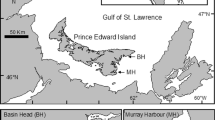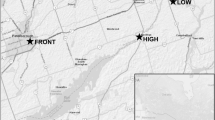Abstract
Some efforts to reduce invasive populations have paradoxically led to population increases. This phenomenon, referred to as overcompensation, occurs when reduced intraspecific pressures increase juvenile survival or maturation rates, leading to increased population size. Overcompensation in response to eradication efforts could derail management efforts, so it would be beneficial to evaluate the likelihood of overcompensation prior to removal. We conducted a series of experiments to examine the potential for overcompensation of a non-native population of the European green crab, Carcinus maenas, which was being removed in Bodega Harbor, California. First, we examined the impact of adults on juvenile survival by measuring adult cannibalism on juveniles in the presence and absence of alternative prey, and the survival of tethered juveniles at varying adult densities. Second, we examined how adult presence affected juvenile short-term foraging and growth rates. Although adult presence reduced juvenile short-term foraging, we detected only minimal cannibalism and found no evidence that adults greatly reduce juvenile growth or survivorship. These results suggest that overcompensation is not likely to occur in this population in response to removal. We assessed this prediction using pre- and post-removal surveys of juvenile recruitment in Bodega Harbor compared to nearby populations, testing for evidence of overcompensation. Relative juvenile abundance did not statistically increase in removal compared to reference populations, consistent with our conclusion from the experiments. This experimental approach which focuses on an organism’s population biology provides a tool to assess capacity for assessing the capacity for overcompensation in management strategies for invasive species.



Similar content being viewed by others
References
Abrams P (2009) When does greater mortality increase population size? The long history and diverse mechanisms underlying the hydra effect. Ecol Lett 12:462–474. doi:10.1111/j.1461-0248.2009.01282.x
Broekhuysen GJ (1936) On development, growth and distribution of Carcinides maenas (L.). Joh. Enschede en Zonen, Haarlem
Buckley Y, Hinz H, Matthies D, Rees M (2001) Interactions between density-dependent processes, population dynamics and control of an invasive plant species, Tripleurospermum perforatum (scentless chamomile). Ecol Lett 4:551–558
Bückmann D, Adelung D (1964) Der Einfluß der Umweltfaktoren auf das Wachstum und den Häutungsrhythmus der Strandkrabbe Carcinides maenas. Helgoländer Meeresun 10:91–103
Carlander KD (1969) Handbook of freshwater fishery biology, vol 1. Iowa State University Press, Ames
Carlton J, Cohen A (2003) Episodic global dispersal in shallow water marine organisms: the case history of the European shore crabs Carcinus maenas and C. aestuarii. J Biogeogr 30:1809–1820
Caskey LL, Riedel RR, Costa-Pierce B et al (2007) Population dynamics, distribution, and growth rate of tilapia (Oreochromis mossambicus) in the Salton Sea, California, with notes on bairdiella (Bairdiella icistia) and orangemouth corvina (Cynoscion xanthulus). Hydrobiologia 576:185–203. doi:10.1007/s10750-006-0301-2
De Rivera C, Ruiz G, Hines A, Jivoff P (2005) Biotic resistance to invasion: native predator limits abundance and distribution of an introduced crab. Ecology 86:3364–3376
De Rivera CE, Grosholz ED, Ruiz GM, et al (2010) Green crab control methods, Phase 3 &3b: expanding capacity to control European Green Crab populations in the Northeast Pacific. Final report for Pacific States Marine Fisheries Commission & NOAA, pp 1–7
De Rivera C, Grosholz E, Ruiz G (2011) Multiple and long-term effects of an introduced predatory crab. Mar Ecol Prog Ser 429:145–155. doi:10.3354/meps09101
De Roos A, Schellekens T, van Kooten T et al (2007) Independent growth leads to overcompensation in stage-specific biomass when mortality increases: the influence of maturation versus reproduction regulation. Am Nat 170:E59–E76. doi:10.1086/520119
Dennis B, Desharnais R, Cushing J, Costantino R (1997) Transitions in population dynamics: equilibria to periodic cycles to aperiodic cycles. J Anim Ecol 66:704–729
DFO (2011) Ecological assessment of the invasive European green crab (Carcinus maenas). In: Newfoundland 2007–2009
Duncombe LG (2014) Evaluating trapping as a method to control the European green crab, Carcinus maenas, population at Pipestem Inlet. Royal Roads University, British Columbia
Dunlop E, Shuter B, Ridgway M (2005) Isolating the influence of growth rate on maturation patterns in the smallmouth bass (Micropterus dolomieu). Can J Fish Aquat Sci 62:844–853. doi:10.1139/F05-045
Everett R, Ruiz G (1993) Coarse woody debris as a refuge from predation in aquatic communities. Oecologia 93:475–486
Ferner M, Smee D, Chang Y (2005) Cannibalistic crabs respond to the scent of injured conspecifics: danger or dinner? Mar Ecol Prog Ser 300:193–200. doi:10.3354/meps300193
Fox L (1975) Cannibalism in natural populations. Annu Rev Ecol Syst 6:87–106
Freeman AS, Meszaros J, Byers JE (2009) Poor phenotypic integration of blue mussel inducible defenses in environments with multiple predators. Oikos 118:758–766. doi:10.1111/j.1600-0706.2008.17176.x
Glude J (1955) The effects of temperature and predators on the abundance of the soft-shell clam, Mya arenaria, in New England. Trans Am Fish Soc 84:13–26
Govindarajulu P, Altwegg R, Anholt B (2005) Matrix model investigation of invasive species control: bullfrogs on Vancouver Island. Ecol Appl 15:2161–2170
Grabowski J, Kimbro D (2005) Predator-avoidance behavior extends trophic cascades to refuge habitats. Ecology 86:1312–1319
Grosholz E, Ruiz G, Dean C et al (2000) The impacts of a nonindigenous marine predator in a California bay. Ecology 81:1206–1224
Heck K, Thoman T (1981) Experiments on predator-prey interactions in vegetated aquatic habitats. J Exp Mar Biol Ecol 53:125–134
Hines A, Ruiz G (1995) Temporal variation in juvenile blue crab mortality: nearshore shallows and cannibalism in Chesapeake Bay. Bull Mar Sci 57:884–901
Jamieson GS, Grosholz ED, Armstrong DA, Elner RW (1998) Potential ecological implications from the introduction of the European green crab, Carcinus maenas (Linneaus), to British Columbia, Canada, and Washington, USA. J Nat Hist 32:1587–1598. doi:10.1080/00222939800771121
Kosior M, Wandzel T (2001) Comparison of fecundity of pikeperch (Stizostedion lucioperca) in three lagoons in the southern Baltic Sea. Bull Sea Fish Inst 3:3–27
Lappalainen J, Dorner H, Wysujack K (2003) Reproduction biology of pikeperch (Sander lucioperca (L.))—a review. Ecol Freshw Fish 12:95–106. doi:10.1034/j.1600-0633.2003.00005.x
McKillup SC, McKillup RV (1992) Inhibition of feeding in response to crushed conspecifics by the pebble crab Philyra laevis (Bell). J Exp Mar Bio Ecol 161:33–43. doi:10.1016/0022-0981(92)90188-G
Meyer KA, Lamansky JA, Schill DJ (2006) Evaluation of an unsuccessful brook trout electrofishing removal project in a small Rocky Mountain stream. N Am J Fish Manag 26:849–860. doi:10.1577/M05-110.1
Moe S, Stenseth N, Smith R (2002) Density-dependent compensation in blowfly populations give indirectly positive effects of a toxicant. Ecology 83:1597–1603
Moir F, Weissburg MJ (2009) Cautious cannibals: behavioral responses of juvenile and adult blue crabs to the odor of injured conspecifics. J Exp Mar Biol Ecol 369:87–92. doi:10.1016/j.jembe.2008.10.026
Moksnes P (2004) Self-regulating mechanisms in cannibalistic populations of juvenile shore crabs Carcinus maenas. Ecology 85:1343–1354
Moksnes P, Lipcius R, Pihl L, van Montfrans J (1997) Cannibal-prey dynamics in young juveniles and postlarvae of the blue crab. J Exp Mar Biol Ecol 215:157–187
Nicholson A (1954) An outline of the dynamics of animal populations. Aust J Zool 2:9–65. doi:10.1071/ZO9540009
Ohlberger J, Langangen Ø, Edeline E (2011) Stage-specific biomass overcompensation by juveniles in response to increased adult mortality in a wild fish population. Ecology 92:2175–2182
Pardini EA, Drake JM, Chase JM, Knight TM (2009) Complex population dynamics and control of the invasive biennial Alliaria petiolata (garlic mustard). Ecol Appl 19:387–397
Peterson C, Black R (1994) An experimentalist’s challenge: when artifacts of intervention interact with treatments. Mar Ecol Prog Ser 111:289–297
Postma JF, Buckert-de Jong MC, Staats N, Davids C (1994) Chronic toxicity of cadmium to Chironomus riparius (Diptera: Chironomidae) at different food levels. Arch Environ Contam Toxicol 26:143–148
Preisser E, Bolnick D, Benard M (2005) Scared to death? The effects of intimidation and consumption in predator-prey interactions. Ecology 86:501–509
R Development Core Team (2012) R: a language and environment for statistical computing. R Foundation for Statistical Computing, Vienna
Ricker W (1954) Stock and recruitment. J Fish Board Can 11:559–623
Rodríguez G (2007) Lecture notes on generalized linear models. http://data.princeton.edu/wws509/notes/
Shanks A, Roegner G (2007) Recruitment limitation in Dungeness crab populations is driven by variation in atmospheric forcing. Ecology 88:1726–1737
Smith PW (1979) The fishes of illinois. University of Illinois Press, Urbana
Smith P, Leah R, Eaton J (1996) Removal of pikeperch (Stizostedion lucioperca) from a British Canal as a management technique to reduce impact on prey fish populations. Ann Zool Fenn 33:537–545
Thuesen P, Russell D, Thomson F et al (2011) An evaluation of electrofishing as a control measure for an invasive tilapia (Oreochromis mossambicus) population in northern Australia. Mar Freshw Res 62:110–118
Trewavas E (1983) Tialpine fishes of the genera Sarotherodon, Oreochromis and Danakilia. Cornell University Press, Ithaca
Trussell G, Ewanchuk P, Bertness M (2003) Trait-mediated effects in rocky intertidal food chains: predator risk cues alter prey feeding rates. Ecology 84:629–640
Weidel BC, Josephson DC, Kraft CE (2007) Littoral fish community response to smallmouth bass removal from an Adirondack lake. Trans Am Fish Soc 136:778–789. doi:10.1577/T06-091.1
Wilson K, Heck K, Able K (1987) Juvenile blue crab, Callinectes sapidus, survival: an evaluation of eelgrass, Zostera marina, as refuge. Fish Bull 85:53–58
Yamada S (2001) Global invader: the European Green Crab. Oregon Sea Grant, Washington Sea Grant, Corvallis, Oregon, p 123
Yamada S, Gillespie G (2008) Will the European green crab (Carcinus maenas) persist in the Pacific Northwest? ICES J Mar Sci 65:725–729
Yamada SB, Kosro PM (2009) Linking ocean conditions to year class strength of the invasive European green crab, Carcinus maenas. Biol Invasions 12:1791–1804. doi:10.1007/s10530-009-9589-y
Yamada SB, Navarrete S, Needham C (1998) Predation induced changes in behavior and growth rate in three populations of the intertidal snail, Littorina sitkana (Philippi). J Exp Mar Bio Ecol 220:213–226
Zimmer-Faust R, Fielder D, Heck K (1994) Effects of tethering on predatory escape by juvenile blue crabs. Mar Ecol Prog Ser 111:299–303
Zipkin EF, Sullivan PJ, Cooch EG et al (2008) Overcompensatory response of a smallmouth bass (Micropterus dolomieu) population to harvest: release from competition? Can J Fish Aquat Sci 65:2279–2292. doi:10.1139/F08-133
Zipkin EF, Kraft CE, Cooch EG, Sullivan PJ (2009) When can efforts to control nuisance and invasive species backfire? Ecol Appl 19:1585–1595
Acknowledgments
For their help collecting data, we would like to thank: B. Kordas, A. Larson, C. Coleman-Hulbert, S. Attoe, I. Clarke, R. Jeppesen, B. Cheng, D. Kimbro, A. Bakus, A. Deck, S. Koetke, C. Brown, G. Ashton, A. Newsom, B. Marshman, B. Powell, C. Kucey and G. Turner. We would also like to thank C. Parker and B. Steves for their invaluable statistical assistance. Financial support was provided (in part) by the, NSF GK12 (# 0948041) in support of BCT, and by Pacific Marine Fisheries Commission and NOAA (## NA06OAR4170261, NA06OAR4170159, NA07OAR4170501, NA08OAR4170927), and Alaska Department of Fish and Game (#IHP-07-146).
Author information
Authors and Affiliations
Corresponding author
Ethics declarations
Conflict of interest
We did not have any conflict of interest in conducting or publishing this work.
Electronic supplementary material
Below is the link to the electronic supplementary material.
Rights and permissions
About this article
Cite this article
Turner, B.C., de Rivera, C.E., Grosholz, E.D. et al. Assessing population increase as a possible outcome to management of invasive species. Biol Invasions 18, 533–548 (2016). https://doi.org/10.1007/s10530-015-1026-9
Received:
Accepted:
Published:
Issue Date:
DOI: https://doi.org/10.1007/s10530-015-1026-9




